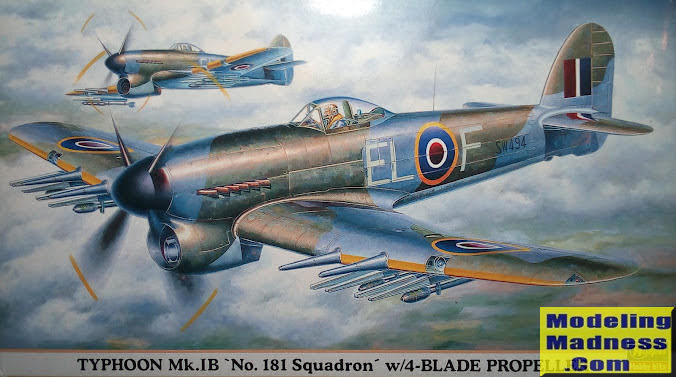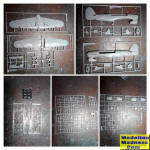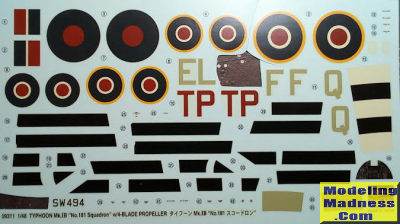
Hasegawa 1/48 Typhoon IB 'Special Version'
| KIT #: | 09311 |
| PRICE: | €24.00 when new |
| DECALS: | Two options |
| REVIEWER: | Spiros Pendedekas |
| NOTES: |

| HISTORY |
Even before Hurricane
production began in March 1937, Sir Sydney Camm had already been designing its
successor, mainly a larger plane that would address the less favored
characteristics of its predecessor. In March 1938, upon receiving from the Air
Ministry the Specification F.18/37, Sir Camm and his design team started formal
development of the designs and construction of prototypes.
The basic design of the Typhoon combined traditional Hawker aspects with more
modern ones. It featured a thick “NACA 22” wing profile, similar to the
Hurricane, whereas the landing gear was “wide track” with heavy duty tires. The
forward fuselage and cockpit skinning was made up of large, removable duralumin
panels, allowing easy external access to the engine and engine accessories and
most of the important hydraulic and electrical equipment.
Whereas the plane was more less otherwise well designed, the thick wing not only
was by far the limiting , for a good performance achievement (mainly top speed,
rate of climb), but also the cause of severe buffeting at high-dive speeds,
where compressibility effects took place.
The Typhoon was rushed into service with Nos. 56
and 609 Squadrons in late 1941, to counter the Fw 190. This decision proved to
be a disaster, mainly due to the Typhoon’s (bitterly experienced) serious bug of
tail design, causing a lot of fluttering that would stress the rear structure
and in many cases cause the tail to be torn off (with catastrophic results, of
course).
Other bugs concerned carbon monoxide fumes seeping into the cockpit and
poisoning the pilot, let alone faulty oil and fuel systems that were the cause
of the many fires experienced, both in air and on the ground. The cockpit was
cramped, complex and offered limited rear visibility, whereas the 24-cylinder
engine also produced a very high-pitched fatiguing sound.
With bugs gradually worked upon, the Typhoon did not begin to mature as a
reliable aircraft until the end of 1942, and not until 1943, when it switched to
ground attack, that the plane came into its own, with the powerful engine
allowing it to carry bomb loads equal to the light bombers of only a few years
before.
3,317 Typhoons were built, almost all by Gloster. Hawker developed what was
originally an improved Typhoon II, but the differences between it and the Mk I
were so great that it was effectively a different aircraft, and was renamed the
Tempest. Once the war in Europe was over, Typhoons were quickly removed from
front-line squadrons. By October 1945 the Typhoon was no longer in operational
use, with many of the wartime Typhoon units being either disbanded or
renumbered.
| THE KIT |
 The Hasegawa series of quarter scale Typhoons first
hit the market in 1999 and had been reboxed by Hasegawa another nine times until
2012, then once by Italeri in 2014 and another six times by Eduard in 2017
onwards as “limited ediions” (with their usual beautiful “extras” - PE, resin,
masks, gorgeous schemes and the like).
The Hasegawa series of quarter scale Typhoons first
hit the market in 1999 and had been reboxed by Hasegawa another nine times until
2012, then once by Italeri in 2014 and another six times by Eduard in 2017
onwards as “limited ediions” (with their usual beautiful “extras” - PE, resin,
masks, gorgeous schemes and the like).
Hasegawa is famous for providing different subject versions by molding a basic
"core model", with the corresponding differentiating parts as “inserts”. The
Typhoon kit is no exception, with different inserts provided to account for the
“car door” or “tear drop canopy” version. Add to that the three or four-bladed
props and, why not, the different armament and: Voila! You have quite a few
“versions” of basically the same kit, which is not a bad thing at all.
Interestingly, one of Hasegawa’s initial releases was labeled as “SUPER DETAIL”
and was beefed-up with a PE fret and resin goodies, something notable back in
1999!
My kit was the 2000s “Special Version” with the bubble canopy and four-bladed
prop. It came in the usual excellent top opening box, featuring a beautiful box
art of two 181 Squadron Typhoons flying together.
Upon opening the box, I was greeted with around 100 dark gray styrene pieces
arranged in nine sprues of various sizes, all bagged together, potentially
scratching each other. From the sprues layout, it is more than obvious that
Hasegawa had designed that kit with the aim to cover all versions of the Typhoon
by using as many common sprues as possible. In this case the specific version is
accounted for by sprues that contain the fuselage inserts for the bubble canopy
version and the 4-blade propeller.
Details are nicely engraved, whereas molding looks superb and crisp (something
to be expected not only by “modern” Hasegawa, but also from the fact that the
specific version it was one of the early moldings), An exception is the presence
of heavy sink marks, practically holes, onto the two gun fairings at one of the
two identical sprues (the other sprue is perfect). Having built the exact same
kit 20 years before, no such discrepancy was evident, so this qualifies as an
isolated case (of probable premature sprue removal from the mold without being
sufficiently cool).
Cockpit detail will be more than adequate for most, with the side tubular frames
and characteristic Typhoon floor well represented. Landing gear parts are also
well represented (no brake lines, but I know I ask too much for the scale…), the
wheels are nicely bulged and wheel wells look realistically busy. The rear wheel
housing is just a small flat plate where the rear wheel strut is attached onto,
with emptiness behind it, but I bet the area would not be that more detailed in
reality
The front radiator, a prominent feature of the Typhoon, is also well
represented, with its rear flap positionable. Two styles of exhaust stacks are
provided. Ordnance is fully catered for, consisting of either two bombs or eight
rockets with their corresponding pylons, all very good looking.
Clear parts are provided in two frets (again, a common and a specific kit
version one) and are very well done. Each is (correctly) bagged separately. The
famous and very handy poly-caps for attaching the prop are also present.
Instructions are provided as a two-pamphlet affair: a “main” pamphlet that is
the instruction sheet of another kit version (three-bladed prop, different
markings) and a complimentary leaflet that accounts for this kit’s build
specifics plus the different marking options. All are nice and clear, with
internal color callouts, whereas some pre-studying of the extra leaflet being
necessary, in order to be successfully incorporated into the main instructions,
nothing too serious though.
Two classic dark green/ocean gray over light gray schemes are provided: one for
a 181 Squadron bird with “early” style top wing roundels (no black and white
stripes), and one 198 Squadron machine that features later style top roundels
and black and white (under-wing and under-fuselage) stripes.
 Decals are the classic 2000s Hasegawa, meaning excellent materials and print
quality, but tad thick and with the typical “ivory” shade at all areas that
should be white (this affects only the second scheme, which is the one I will
do, since I had used a decal from the other scheme to fix a goofing I did at my
past build of the same kit…).
Decals are the classic 2000s Hasegawa, meaning excellent materials and print
quality, but tad thick and with the typical “ivory” shade at all areas that
should be white (this affects only the second scheme, which is the one I will
do, since I had used a decal from the other scheme to fix a goofing I did at my
past build of the same kit…).
Instructions want you to first assemble the cockpit and radiator, then trap them
between the fuselage halves. The famous inserts that account for the “tear drop
version are then attached, followed by assembly and installation of the main
wing and horizontal stabilizers. All landing gear parts (sans main
wheels), together with the pitot, antenna mast and the radiator flap are then
supposed to be attached (I prefer to install such parts after painting, as they
are too fragile).
The various lights are also supposed to be attached during the above step: trusting Hasegawa for good fit, I will attach them after painting, saving some masking. Next is ordnance assembly and installation (gun fairings included), finishing with prop and main wheels assembly and attachment, together with the exhausts and transparencies.
| CONCLUSIONS |
Though slowly getting elderly, this is definitely a
very good kit of the iconic Typhoon with correct general shape and reportedly
good fit. Detailing at key areas is very good, instructions are clear and decals
are expected to behave well, with the drawbacks of relative thickness and the
white representation as ivory (the latter affects only one of the two schemes).
This kit builds very well, as several Modelingmadness build reviews indicate.
Whereas parts count is not that low, a good number of them cater for the rockets
ordnance. It is not a complex kit and I would not hesitate to recommend it to
anyone but the absolute beginner.
Aftermarket of all kinds exists, being plentiful and impressive. Eduard have
also reboxed all versions in 2017 and 2018, with their amazing assortment of
goodies inside (PE, resin, masks, very interesting schemes and so on), but their
editions are of the “limited run” kind and are not too easy to find nowadays
(2021).
Whereas Hasegawa hasn’t reissued any version of the kit since 2012, they can
still be found at good prices. If you fancy building a Typhoon and own one of
these kits or come across one, you are warmly advised to do so: an imposing
model of the iconic fighter/attacker will result for sure.
Happy modeling!
November 2021
Copyright ModelingMadness.com. All rights reserved. No reproduction in part or in whole without express permission.
If you would like your product reviewed fairly and fairly quickly, please contact the editor or see other details in the Note to Contributors.